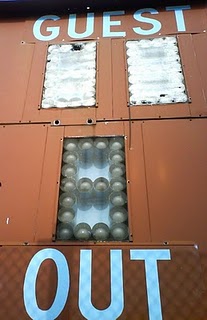There are few places left in Berlin where the experience of American occupation after the Second World War is still vividly felt. The most famous (and touristic) is the crossing between the American and Soviet sectors at Checkpoint Charlie. The US Army headquarters was in Zehlendorf, where some of the buildings have been taken over by the State Department and others were razed to the ground. Still scattered around the city are a number of American chapels, schools and dedicated libraries –but these remains are few and exert little presence.
For me, the most vivid reminders of the American occupation (which lasted until 1994) are the US Army Baseball/Softball diamonds which remain on the site of the old Tempelhof Airport (see my previous blog entry). The diamonds are non-descript. The Berlin’s Mixed Softball League, which will take them over this year, has some weeding to do.
What I find most surprising are the scoreboards, whose vintage technology seems transplanted from a fifties cornfield at the centre of the North American continent. I see the bulbs illuminating, the crack of the ball propelling from the bat, the shuffling of feet through the sand, and American voices calling out strike. The scene is perhaps illuminated, at night, with young American servicemen, transplanted from their distant realities, rushing between the bases. Overlooking it, most poignantly, are those two words, ‘Home’ and ‘Guest’.
And ultimately, there is another word, which is ‘Out’.
Größere Kartenansicht


Hey Joseph,
There are plenty of much more vivid reminders of the American presence ("occupation" is a bit strong, no?) than those at Tempelhof. Check out the area around Oskar-Helene-Heim in person, if you haven't already. The old Baskin-Robbins, Burger King and PX (where my ultra-left-wing Kreuzberg roommates in 1992 always wanted me to buy American stuff for them – harhar) are gone, as you point out, but the Harnack-House and Checkpoint restaurant where I used to work are still there, as are the gym, the old U.S. library, Andrews Barracks (now some kind or archive on GDR history) with the old swimming pool used in the 1936 Summer Olympics and a New-England-style chapel, and McNair Barracks with a segment of what was going to be a big autobahn ring around Berlin, etc. The Army presence was much more significant than that of the Airforce (at Tempelhof). The Benjamin Franklin Hospital is also worth a visit.
This being said, there's still a ton of U.S. stuff right beneath the main terminal building at Tempelhof, including a barber's shop and an old U.S. bowling alley — all sealed off to the public now, like the rest of that amazing building.
Matthew
Dear Matthew,
Thanks so much for your comments. What I like about the baseball diamonds most is the scoreboard, very much out of time and still in use by Berliner kids. I know there are many other vivid reminders of the American occupation in Berlin, but it is a matter of preference what strikes one as most poignant. It's certainly not the most obvious example of Americana, and I would LOVE to check out the bowling alley! Do you have the keys?
As for occupation vs. presence, I see things very much in the context of the end of WW2 and German defeat. I know that most Berliners were happy to find themselves in the American quarter than the Soviet one, but this does not change the fact that the country was divided and occupied by the armies of foreign powers.
Best wishes!
Joseph